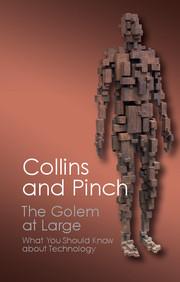Book contents
- Frontmatter
- Dedication
- Contents
- Preface and acknowledgements
- Introduction: the technological golem
- 1 A clean kill?: the role of Patriot in the Gulf War
- 2 The naked launch: assigning blame for the Challenger explosion
- 3 Crash!: nuclear fuel flasks and anti-misting kerosene on trial
- 4 The world according to Gold: disputes about the origins of oil
- 5 Tidings of comfort and joy: Seven Wise Men and the science of economics
- 6 The science of the lambs: Chernobyl and the Cumbrian sheepfarmers
- 7 ACTing UP: AIDS cures and lay expertise
- Conclusion: the golem goes to work
- References and further reading
- Index
5 - Tidings of comfort and joy: Seven Wise Men and the science of economics
Published online by Cambridge University Press: 05 June 2014
- Frontmatter
- Dedication
- Contents
- Preface and acknowledgements
- Introduction: the technological golem
- 1 A clean kill?: the role of Patriot in the Gulf War
- 2 The naked launch: assigning blame for the Challenger explosion
- 3 Crash!: nuclear fuel flasks and anti-misting kerosene on trial
- 4 The world according to Gold: disputes about the origins of oil
- 5 Tidings of comfort and joy: Seven Wise Men and the science of economics
- 6 The science of the lambs: Chernobyl and the Cumbrian sheepfarmers
- 7 ACTing UP: AIDS cures and lay expertise
- Conclusion: the golem goes to work
- References and further reading
- Index
Summary
Shortly after the Second World War, an engineer from New Zealand, ‘Bill’ Phillips, working at the London School of Economics, built a model of the economy. The marvellous thing about this model was that it ran on water. Phillips's model was a set of tanks, valves, pumps, pipes, baffles and cisterns. If, say, the flow into some cistern increased while the cross section of the output remained the same, the water in the cistern would rise. The new level might increase the flow of water into another cistern, raising its level, or it might be enough to trigger a valve and restrict the flow somewhere else. The whole thing, which stood about seven feet high, weighed a good part of a ton, and was prone to leakage and corrosion, was meant to represent the flows of income around a national economy. Changes of levels were linked by indicators to scales which represented measures of economic performance such as price indices, stocks of money, or Gross National Product. It was even possible to link one of these gurgling monsters to another, thus representing the interaction of two national economies, or the interaction of one economy with the rest of the world. Phillips's hydraulic model of the economy has been restored recently and can be seen at the Science Museum in London.
Nowadays no one would dream of building a model of the economy that ran on water. Nowadays one would use a computer and the relationships would be represented by interacting mathematical equations. Using a computer and equations one can build the equivalent of many more pipes, tanks, and valves than one could ever construct with plumbing. This is what macroeconomic modellers do; they use equations to build a model of the economy. They model not only theoretically derived relationships but quantities based on observations of how this or that change has appeared to affect the economy in the past. Modern models may have hundreds of equations and variables arranged in a big tree-like structure representing everything from world interest rates to levels of business and consumer confidence; the output of some equations will count as variables in other equations, while these effect still other equations and so forth. A modern model rendered hydraulically in the style of Phillips would be big enough to flood the LSE and the surrounding streets.
- Type
- Chapter
- Information
- The Golem at LargeWhat You Should Know about Technology, pp. 123 - 148Publisher: Cambridge University PressPrint publication year: 2014

